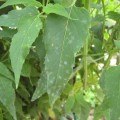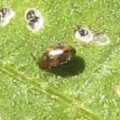Clubroot is caused by the soil-borne fungus Plasmodiophora brassicae, and it is the most serious disease of the brassica family.
Physical Description
- Very serious problem where fungus attacks roots and kills the plant
- Google images of clubroot
Species & Taxonomy
- Kingdom: Rhizaria
- Phylum: Cercozoa
- Class: Phytomyxea
- Order: Plasmodiophorales
- Family: Plasmodiophoraceae
- Genus Species: Plasmodiophora brassicae
Lifecycle
- spores are released into the soil
- can survive in the soil without a suitable host for up to 20 years REOG
- disease is spread on infected plant material and contaminated soil REOG
Plants Affected
Plants Unaffected
- Brassicas (broccoli, cabbage, kale, cauliflower, mustards, radish): clubroot is the most serious disease of brassicas
- wallflower
- stocks
- candytuft
Geographical Range
Signs & Symptoms
Whole Plant
- stunted growth
- eventual plant death
- wilt on hot sunny days, but may recover at night REOG
- plant growth and crop yields are severely reduced REOG
Leaves
- leaves start to discolor
- red tint may develop on foliage REOG
Flowers
Fruit
Roots/Tubers
- roots develop swollen galls (either a single large gall, or several smaller swellings) REOG
How to Positively Identify
Treatment
- spores can survive 20 years dormant in the soil
- there is no cure
- solarization probably doesn’t help, if the fungus doesn’t get killed in a hot compost pile (140°F)
- burn or dispose of diseased plants and soil surrounding the plant (do not compost)
Prevention & Control
This disease is very difficult to control, so avoidance is very important
Cultural Controls:
Habitat:
Temperature & Humidity:
- it is less of a problem in hot, dry seasons REOG
- less of a problem in spring-maturing crops REOG
- it thrives in damp, acid conditions REOG
Mulching & Cultivation Practices:
- buy transplants from a reliable source, or raise your own
- build up good soil fertility and improve drainage REOG
- lime acid soils: alkaline soil (pH at or above 7) discourages clubroot
- remove infected plants as soon as possible, preferably before the galls start to disintegrate REOG
- do not compost infected plants REOG
- practice good garden hygiene (clean implements, gloves and shoes; move cuttings and prunings to compost or disposal right away)



